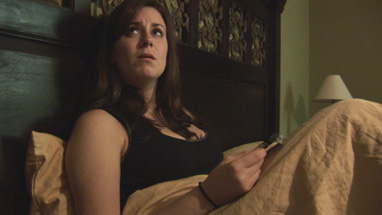Top 12 Film Industry Stories of 2009:
#3: Paranormal Activity Scares Up Some Dough
By David Mumpower
January 2, 2010
Consider the following: Paranormal Activity's first weekend per-venue average was $6,489 at 12 theaters. The second weekend's per-venue average was $16,129 at 33 theaters. The third weekend's per-venue average was $49,694 at 160 theaters. These numbers are exactly backwards of how the process is supposed to work. In fact, the third weekend per-venue average by itself represents a factor of three more than the film cost to make. I guess that audiences want to be shocked about once a decade by a homemade horror film.
Paranormal Activity finished its ascension from midnight venue to novelty to box office champion in its fifth weekend in theaters, earning $21.4 million. This unlikely turn of events completed a stratospheric box office ascension wherein the title debuted in 47th place in its first weekend (consisting exclusively of midnight exhibitions), rose to 20th place in its second weekend, jumped all the way up to fourth place in its third weekend, edged up to third place in its fourth weekend and finally won in its fifth weekend in theaters. Stating the obvious, the marketing team at Paramount Pictures hit the most dramatic homerun of their careers with this title.
The distributor paid only $350,000 for the rights to the home video production. The worldwide total revenue of $141.7 million makes Paranormal Activity the box office equivalent of a penny stock that evolves into a Fortune 500 company. In terms of per-location average, the platform expansion saw a per-location INCREASE from $6,489 in 12 (midnight) exhibitions to $16,129 in 33 exhibitions to $49,379 in 160 locations. That's the opposite of how the process is supposed to works. Titles should decline in per-location average as they garner more exhibitions.
Paranormal Activity even broke rules once it went national and eventually entered into wide release. After earning $25,711 from 763 venues, its expansion into 1,945 locations meant a drop of only 56% to $11,311. Most titles that expand this much drop somewhere around 70-80% in terms of per-location. The end result is that for five (!) straight weekends, the little horror film that could increased in weekend revenue. It jumped from $77,873 in 12 locations (with only midnight showings) to $532,242 in 33 locations (583% growth) to the aforementioned $7.9 million in 160 locations (1384% growth) to $19.6 million in 763 locations (148%) growth to $21.2 million in 1,945 locations with 12% worth of additional growth. Along the way, it not only eviscerated the reigning king of horror, the Saw franchise, but also desecrated its corpse on the way out. Saw VI's final domestic revenue of $27.6 million is not only easily the worst in the franchise's history; it is also a lower total than the four prior Saw releases earned on their opening weekends alone. Paranormal Activity completely stole Saw's thunder and made that franchise look as old and tired as it frankly is.
There is a large deal of irony in this regard. To a certain extent, the success of Paranormal Activity is an example of history repeating itself. In October of 2004, a production with a minuscule $1.2 million budget (which would pay for roughly 100 Paranormal Activities, but I digress) shocked the industry by earning $18.3 million. The original Saw would go on to earn $55.2 million for Lionsgate, and the studio quickly realized they should do a sequel. Every year. No matter what. While the original Saw never won a box office weekend, Saw II, III and IV all dominated the competition, each opening in first place with $31.7-$33.6 million. Saw V absorbed a small amount of slippage as it became the first film since the original to fail to finish in first place. The unlikely combatant, High School Musical 3: Senior Year, beat it handily, $42.0 million to $30.0 million; however, Saw V was still a huge success relative to its $10.8 million budget. Frugal production cost has been the hallmark of this franchise. All of the titles have been made in the $10 million range, which is all that kept Saw VI from being a financial disaster. Had it cost more than $11 million, it would be a box office train wreck. As it is, this is instead a shining example of how opportunity cost can be significant in the box office realm through lost market share, even for titles that are theoretically profitable.
With Saw humiliated, Paranormal Activity firmly established itself as the top horror release of the year, the buzz title that everyone had to see. The result of this is that a film that was originally planned to be re-made instead of released in its original format became arguably the most lucrative movie release of the 2000s. Paramount has already announced intentions for a sequel, which is again a case of history repeating itself. Let's hope that Paranormal Activity 2 has a better fate than Book of Shadows, the Blair Witch sequel that earned only 18.8% of its predecessor's domestic take despite costing about 430 times as much.
Continued:
1
2

![]() Tweet
Tweet
![]() Print this column
Print this column



